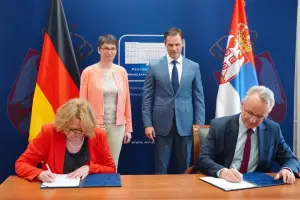- Serbia
Get to know Serbia
- Citizens
Culture and science
Health services
Pension and disability insurance
- Business
Employment
Economy
- Media
- Government
- Contact
Keep in touch
Contact form
Back
Keepin touch
Whether you have a question, comment, suggestion or any problem in the purview of the government, send us your message and we will try to respond as soon as possible. If your problem is not in our purview, we will forward your message to the relevant institution.
Q:
A:
Foreign trade increases 6% in 2005
Belgrade,
31 January 2006
The Serbian Statistical Office stated today that the overall foreign trade of the Republic of Serbia in 2005 totaled $15.12 billion, which is 6% larger compared to 2004.
Expressed in euros, the volume of foreign trade stood at €12.199 billion, marking an increase of 6.5% against the previous year.
Exports stood at $4.55 billion, up 29.2% from a year earlier, while imports totaled $10.57 billion, a 1.7% drop in relation to 2004.
Expressed in euros, exports jumped 29.5 percent to €3.66 billion, while imports went down 1.1% to €8.53 billion in relation to the previous year.
Reduced imports in 2005 are a result of the introduction of value added tax (VAT). Import of many goods planned for the beginning of the year was made in December 2004, ahead of the launch of the new tax in order to avoid VAT payments by importers for the first couple of months of 2005. VAT also affected export results, because exporters are now declaring real values of their shipments in order to claim VAT refunds.
Surging exports were also driven by the initial effects of privatisation and the restructuring of companies, by signed and ratified free trade agreements with countries who are signatories of the Stability Pact for South Eastern Europe, and by food and ready-made textile goods trade surplus, thanks to the agreement signed with the EU.
The trade deficit in 2005 stood at $6.022 billion, down by 16.7% against 2004. Expressed in euros, the deficit stood at €4.86 billion, down by 16%.
Exports-to-imports ratio was 43 percent, marking an increase in relation to 2004, when that figure stood at 32.8%.
Most exported items in 2005 were intermediate goods, accounting for 66.3% ($3.020 billion) of overall exports, followed by consumer goods, which made up 27.5% ($1.25 billion) and equipment, making up 6.2 percent ($282.1 million) of total exports.
Imports were also dominated by intermediate goods, 62.2 percent ($6.57 billion), consumer goods, 21.2 percent ($2.24 billion), and equipment, 16.6 percent ($1.75 billion) of overall imports.
Major importers of Serbian goods were Bosnia and Herzegovina ($748.4 million), Italy ($656.5 million), and Germany ($445.8 million), while the largest exporters to Serbia were Russia ($1.67 billion), Germany ($1.092 billion), and Italy ($908.8 million).
The greatest portion of foreign trade in 2005 was recorded in commerce with the EU, which accounted for more than half of total trade. The overall trade ratio with Italy is more favourable than in 2004, when the deficit was $592 million. In 2005, that deficit was reduced by half and amounted to $252 million.
The biggest surplus was recorded in trade with Bosnia-Herzegovina, $456 million. Thanks to the free trade agreement, as well as the competitiveness of Serbian products, a surplus has also been achieved in commerce with Macedonia, while a deficit remained in commerce with Russia, due to energy imports, mainly oil and natural gas.
Exports stood at $4.55 billion, up 29.2% from a year earlier, while imports totaled $10.57 billion, a 1.7% drop in relation to 2004.
Expressed in euros, exports jumped 29.5 percent to €3.66 billion, while imports went down 1.1% to €8.53 billion in relation to the previous year.
Reduced imports in 2005 are a result of the introduction of value added tax (VAT). Import of many goods planned for the beginning of the year was made in December 2004, ahead of the launch of the new tax in order to avoid VAT payments by importers for the first couple of months of 2005. VAT also affected export results, because exporters are now declaring real values of their shipments in order to claim VAT refunds.
Surging exports were also driven by the initial effects of privatisation and the restructuring of companies, by signed and ratified free trade agreements with countries who are signatories of the Stability Pact for South Eastern Europe, and by food and ready-made textile goods trade surplus, thanks to the agreement signed with the EU.
The trade deficit in 2005 stood at $6.022 billion, down by 16.7% against 2004. Expressed in euros, the deficit stood at €4.86 billion, down by 16%.
Exports-to-imports ratio was 43 percent, marking an increase in relation to 2004, when that figure stood at 32.8%.
Most exported items in 2005 were intermediate goods, accounting for 66.3% ($3.020 billion) of overall exports, followed by consumer goods, which made up 27.5% ($1.25 billion) and equipment, making up 6.2 percent ($282.1 million) of total exports.
Imports were also dominated by intermediate goods, 62.2 percent ($6.57 billion), consumer goods, 21.2 percent ($2.24 billion), and equipment, 16.6 percent ($1.75 billion) of overall imports.
Major importers of Serbian goods were Bosnia and Herzegovina ($748.4 million), Italy ($656.5 million), and Germany ($445.8 million), while the largest exporters to Serbia were Russia ($1.67 billion), Germany ($1.092 billion), and Italy ($908.8 million).
The greatest portion of foreign trade in 2005 was recorded in commerce with the EU, which accounted for more than half of total trade. The overall trade ratio with Italy is more favourable than in 2004, when the deficit was $592 million. In 2005, that deficit was reduced by half and amounted to $252 million.
The biggest surplus was recorded in trade with Bosnia-Herzegovina, $456 million. Thanks to the free trade agreement, as well as the competitiveness of Serbian products, a surplus has also been achieved in commerce with Macedonia, while a deficit remained in commerce with Russia, due to energy imports, mainly oil and natural gas.
-
 Belgrade/Athens, 17 July 2025
Belgrade/Athens, 17 July 2025Serbia continues to align with EU in field of energy
-
 Kostolac, 14 July 2025
Kostolac, 14 July 2025First solar power plant Petka in Kostolac put into trial operation
-
 Belgrade, 11 July 2025
Belgrade, 11 July 2025Potential for improving cooperation with Belarus in many areas
-
 Požega, 5 July 2025
Požega, 5 July 2025Section of Pakovraće - Požega highway officially opened
-
 Belgrade, 2 July 2025
Belgrade, 2 July 2025Technical specifications defined for Serbia-Hungary oil pipeline
-
 Belgrade, 30 June 2025
Belgrade, 30 June 2025IMF confirms Serbia successfully implementing all agreed reforms
-
 Belgrade, 27 June 2025
Belgrade, 27 June 2025Double Taxation Avoidance Agreement with Germany signed
-
 Kostolac, 25 June 2025
Kostolac, 25 June 2025Construction of Kostolac wind farm nearing completion
-
 Belgrade, 24 June 2025
Belgrade, 24 June 2025Government supports request for new postponement of sanctions against NIS
-
 Belgrade, 23 June 2025
Belgrade, 23 June 2025Procedures to facilitate sale of Serbian products to China to be accelerated
